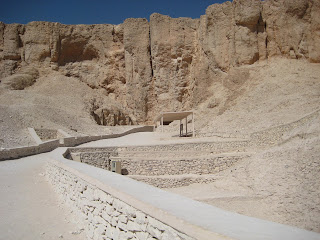One thing of note I should point out, that Luxor ruins are separated by the Nile and categorised into two sections; the East bank, and the West bank. The East bank being temples celebrating life, and the West bank (not to be mistaken for the Palestinian West bank) is for tombs and the dead. Interestingly this was symbolic of the rising sun in the East (life) and setting sun in the West (death). OK, that is enough of me pretending to be educational - next I will be sewing leather patches on my tweed jackets!!
The first visit was to Habu temple. Immediately I could see that these temples are not on most travel companies usual Luxor itinerary, as the temple was sparsely populated with tourists, which is always a good thing from a snapping point of view. My tour guide was a local girl called Emmi, who has been training at Luxor University and was giving me a one-to-one tour of the temples. She was friendly and informative, but I did feel sorry for her, as being Ramadan, she has to abstain from food and water from sunrise until sunset. In this particular heat that must be a nightmare to achieve.

More columns, these ones were cut down and "Copticised" (sounds painful)
Sure enough as we were wending our way through the temple, we crossed paths with people lying down in the shade hiding from the sun, but Ra had managed to fire his nasty rays on some old girl’s head, and she was collapsed on the floor with heat exhaustion, being fanned by one of the Nubians in the temple whose only purpose (as far as I can see) is to collect baksheesh.
The crowd of people in shot are trying to help the heatstroke woman -
I helped as best i could, by taking a photo (how inconsiderate of me!)
As we were going around the temples I realised that quite a bit of the stuff that had been told to me over the past few days had actually sunk in, and I found myself answering a lot of her questions with semi-sensible answers.
After Habu temple, we moved on to the Valley of the Nobles. This is obviously not as grand as Valley of the Kings, but it did have some very nice artistry in the tombs. As with the Valley of the Kings, we could not take any photos in here, but for a bit of baksheesh, I managed to snap a couple while the other tourists were not looking (this is a standard arrangement with the guards).

Those Egyptians were seriously advanced. Here is
an ancient fire extinguisher in the tomb of Ramose
The tombs were a welcome break from the searing heat of the sun at this point, but it was not long enough in the shade, and all too soon we were back out on the road heading towards the Ramesseum.
However, before that I was given the little chat about how papyrus is made and the skill of these people. I knew exactly where this line of conversation was heading, having been subjected to it on 2 occasions before, once prior to the alabaster village and the other prior to the aromatherapy shop. Before she could finish her talk on it, I declared that I was not interested in seeing how it is made, or going to the shop, which seemed to disgruntle her a little bit, but I am the customer, and the customer is always right ;)
Anyway, I watched a whole video of how they made the papyrus scrolls at the Luxor museum yesterday, so did not need them to tell me.
 The Ramesseum - another temple ticked off the list
The Ramesseum - another temple ticked off the list A very hot me, trying to look cool at the Ramesseum
A very hot me, trying to look cool at the Ramesseum
We then headed back to the hotel, and I spent the rest of the afternoon avoiding the heat of the day, watching TV and popping out to the shops for 10 minute bursts.
Tomorrow I am booked on an early morning flight to Cairo, where I aim to see the Pyramids. I am booked into the Nile Hilton, which is right next to the Egyptian Museum. I am hoping that Cairo will be considerably cooler than Luxor, and looking at the forecast on the BBC website this seems to hold true, it will be low 30s, whereas it was over 43 degrees here today.








































